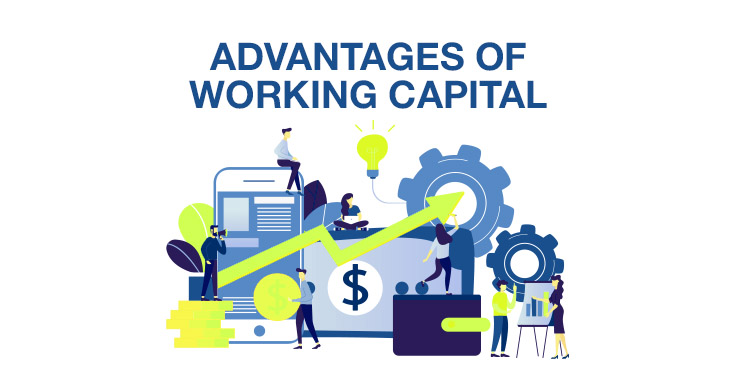The sound financial foundation and the routine operational performance of a firm are determined by efficient working capital finance. Its management bring about a strong balance between growth, profitability and liquidity. These in turn are indicators of successful company management.
The working capital of a company is the difference between a company’s current assets and current liabilities or debts. It is imperative for the everyday operations of every firm. A measure of a company’s effective operational capacity as well as short-term financial stability is through its working capital finance. The working capital ratio reveals a company’s ability to generate enough cash flow to pay short-term obligations and costs. This important metric is calculated by dividing current assets by current liabilities.
Importance of WCF For Businesses In The Current Scenario
Businesses require working capital for a consistent stream of cash in order to make bill payments on time, to be able to cover unforeseen expenses. Making purchase of raw materials for manufacturing goods is another important aspect.
With effective working capital finance, a business can very smoothly run its operations while enhancing its revenue and profitability. It also includes inventory management which incorporates accounts receivable and payable management, along with working capital management.
Maintaining the working capital finance through the operating cycle helps assure orderly functioning of the business at lower capital costs. Working capital finance also helps in increasing the return on current asset investments, being the major goal of working capital finance and management.
Working capital is related to a person’s cost of living and is a simple concept to grasp since it can be comprehended in a more individualised manner. In layman terms, it is similar to people recovering the money that is owed to them and saving a set amount each day in order to meet their everyday obligations like paying their bills.
Working capital finance is an efficient indicator that can be used to predict a company’s productivity, liquidity, as well as general health. It reflects outcomes of a variety of business operations, like debt management, revenue collection, inventory management, as well as making payments to the suppliers. This owes to the fact that it consists of inventories, accounts payable and receivable, cash, debt that are partially due within a year, along with other short-term accounts.
Working Capital Finance: A Brief Overview
Working capital finance is a commercial financing method that intends to give a boost to the working capital of a business. It’s mostly used for targeted expansion initiatives, like making an investment in a new market, accepting a larger contract, etc to name a few.
The method of Working capital finance can be used by firms for a variety of reasons, with the same fundamental notion of utilising it to free up money that will be repaid in the short- to medium term and use it for expansion of the business. Numerous financing products in the markets these days can fall under the category of working capital finance.
While some are helpful for working capital in a genetic context (regardless of the industry your business is a part of), or being excellent for certain specific needs or industries.
Why Do Businesses Need Working Capital Finance?
Despite negative cash flows, we often witness numerous businesses manage to survive. If you are above reproach, you can land your firm in a far better position.
Here are the top 5 reasons why having access to working cash can prove crucial for businesses:
- Prepare for unexpected situations and contingencies: Working capital financing means setting aside money for unforeseen emergencies for your business works in the same way you set aside money for your personal emergencies. Imagine you need funds and your primary client closed their doors. What options do you have? Or what if you find yourself as a target of a lawsuit? What about the case of a natural calamity? Your budget will bear considerable brunt in all the above mentioned scenarios. However, with operating cash on hand, you’re always better equipped to efficiently deal with these unforeseen expenses.
- Control idle time: Experiencing downtime is a part and parcel of running a business, especially if you’re a seasonal business. For instance, you could make a significant portion of your sales during the summer or during the festival season. You’ll require access to enough working cash throughout the busy seasons of your business. Working capital finance can save you in such situations.
- Short-term debt commitments: Using short-term debt is almost a routine practice for many businesses these days. This is because debt commitments can be easily managed with adequate in-hand working cash. However, with working capital finance, you can take of your commitments in an even easier manner.
- Expansion and development: Whether it’s about growing your company to a new level or just some routine expansion, in order to be agile you need to be handy with operating money. Thus, working capital finance lauds you with the ability to take swift action. As a negative cash flow is always detrimental when you’re trying to expand or grow your business.
- Mental calm: You’re always “on-edge” with worries for funds as any mishaps mean a considerable financial loss. However, having enough operating capital on hand for your personal peace of mind is an excellent way to cushion your business and working capital finance is just the perfect way to do that.
Using these following steps, you can improve your supply chain
- Conducting thorough market research
- Pre-deciding on ideal timings suitable for availing working capital finance in india
- Be wary of any possible additional costs
- Learn about all your repayment options
Types of Working Capital Finance Options Available in India
There are numerous forms of loans for working capital finance, each with its benefits and drawbacks. The best option for a business depends upon how much money the borrower needs for their needs. There are several other ways for firms to finance their working capital.
The three most common types of credit are those stated below:
- Loans advances made for a short period of time: These loans are given at fixed interest rates and mostly have a fixed duration of six to twelve months. Short term loans can be readily obtained by a borrower with good credit with little to no paperwork, no collateral, and no verification. It is excellent for businesses that have strong immediate credit needs.
- Banking overdraft: This working capital is lent by banks to their commercial clients. Whenever a client account runs out of money to cover costs, banks permit an overdraft which helps the consumer fulfil their cash flow needs. Interest rates for bank overdraft are typically fixed and higher than those charged on loans.
- Accounts Receivable Financing: This financing for companies is suitable for those businesses who simply need money to make payments for the orders that have already been made. Getting these loans is simple, especially in case of borrowers having purchase orders that must be completed. Here, lenders typically require a promise to pay (PTP) note as a proof that the borrower will truly repay the principal amount plus interest after getting paid for their orders.
Difference Between WCF Through TReDS and Business Loan
In contrast to invoice discounting/bill discounting, where the seller only receives a portion of the bill, in bill purchasing the seller receives the whole amount of the bill and the bank receives the commission.
Bill discounting is a great choice for your company as long as you follow strict credit management measures and keep your debt levels low. TReDS is a digital marketplace created by the RBI to make it easier for MSMEs to reduce bills from corporate purchasers through various financiers. There are several bill discounting platforms available.
One of India’s Top Platforms For Invoice Discounting is M1xchange.
- TReDS has emerged to be one of the most effective medium for working capital financing for MSMEs
- TReDS will help MSMEs to improve the supply chain through working capital financing
To know more about the TReDS platform, visit the website.
Also read these – SME Finance, Invoice Financing, Accounts Receivable Financing, Supply chain financing
Tags: working capital, working capital solution Last modified: September 29, 2023


















